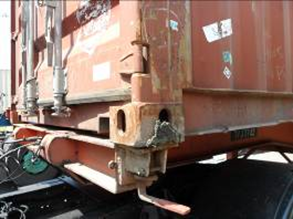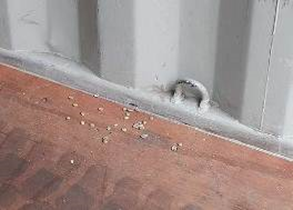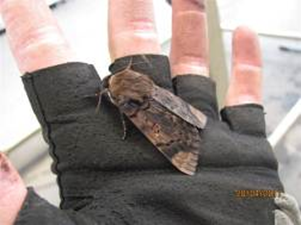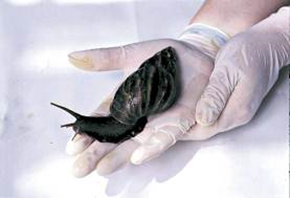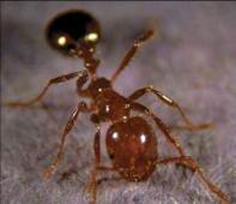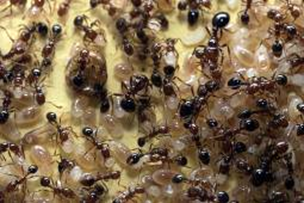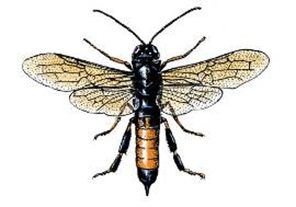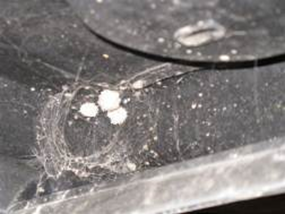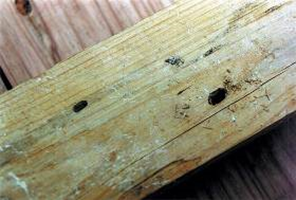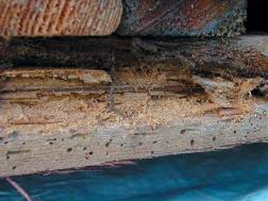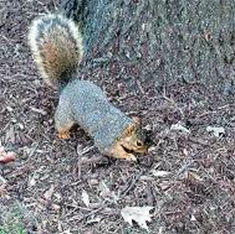3.1 Soil
3.1.1 Soil can contain spores, seed and eggs of one or more invasive alien species, and therefore should not be carried on or in the CTU internationally. Soil can be found at floor level in the internal corrugations of the side wall, in the internal angles of the corner posts and externally in the corner fitting apertures and body, fork pocket openings and on the upper surfaces of the cross rail bottom flanges (see figures 6.2 and 6.3).
Figure 6.2 Mud in corner fitting |
Figure 6.3 Mud in fork pocket |
3.1.2 Recontamination of the CTU will generally result from positioning the CTU on mud, or a soft surface. Care should be taken to prevent the CTU from scraping across the ground surface.
3.1.3 Soil can also enter the CTU on the feet of persons, on the wheels of handling equipment and on the packages or goods themselves.
3.1.4 Soil should be swept out and bagged for incineration or washed out using a high pressure spray.
3.2 Plants/plant parts/debris and seeds
3.2.1 Plants can grow on CTUs if residual seed has been allowed to germinate with or without contaminating soil (see figure 6.4). Other plant matter found on CTUs includes leaves and other plant parts. Leaves can harbour spores and bacteria that can harm crops at the destination.
Figure 6.4 Previous cargo debris |
3.2.1.1 Moths
Figure 6.5 shows examples of moths.
Figure 6.5 Asian gipsy moth | |
3.2.1.2 Snails and slugs
Figure 6.6 shows examples of snails.
Figure 6.6 Giant African snail | |
3.3 Ants
3.3.1 Some ant species are considered pests, and because of the adaptive nature of ant colonies, eliminating the entire colony is nearly impossible. Pest management is therefore a matter of controlling local populations, instead of eliminating an entire colony, and most attempts at control are temporary solutions.
Figure 6.7 Pharaoh ant | Figure 6.8 Carpenter ant nest |
3.3.2 Ants classified as pests include the pavement ant, yellow crazy ant, sugar ants, the Pharaoh ant (see figure 6.7), carpenter ants (see figure 6.8), Argentine ant, odorous house ants, red imported fire ant and European fire ant. Populations are controlled using insecticide baits, either in granule or liquid formulations. Bait is gathered by the ants as food and brought back to the nest where the poison is inadvertently spread to other colony members through trophallaxis. Boric acid and borax are often used as insecticides that are relatively safe for humans. Bait may be broadcast over a large area to control species like the red fire ant that occupy large areas.
3.3.3 Individual ants should be swept out of CTUs if possible, but larger colonies or infestations, require the entire colony to be destroyed and removed for incineration.
3.4 Bees and wasps
Figures 6.9 and 6.10 show examples of wasp and wasp nest.
Figure 6.9 Sirex wasp | Figure 6.10 Sirex wasp nest |
3.5 Mould and fungi
When CTUs are left in damp, dark conditions fungi and other airborne spores can lodge and grow on the residual soil left on surfaces of a CTU.
3.6 Spiders
Figures 6.11 and 6.12 show examples of spider and spider eggs.
Figure 6.11 Wolf spider | Figure 6.12 Spider eggs |
3.7 Frass
3.7.1 Frass is the fine powdery material phytophagous (plant-eating) insects pass as waste after digesting plant parts. It causes plants to excrete chitinase due to high chitin levels, it is a natural bloom stimulant, and has high nutrient levels. Frass is known to have abundant amoeba, beneficial bacteria, and fungi content. Frass is a microbial inoculant, also known as a soil inoculant, which promotes plant health using beneficial microbes. It is a large nutrient contributor to the rainforest, and it can often be seen in leaf mines.
3.7.2 Frass can also refer to the excavated wood shavings that insects like the carpenter ants kick out of their galleries during the mining process. Carpenter ants do not eat wood, so they discard the shavings as they tunnel (see figure 6.13).
Figure 6.13 Wood frass from boring insect | |
3.7.3 Frass is a general sign of the presence of a wood boring or another insect and therefore in need of cleaning. It is essential that affected plants or timber be removed and incinerated.
3.8 Animals (including frogs)
Figure 6.14 shows examples of animals.
Figure 6.14 Squirrels and frogs | |
